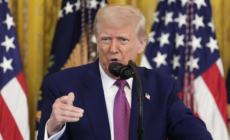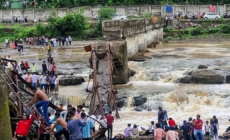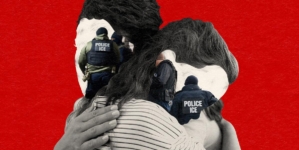-
How to Watch Coastal Carolina vs Oregon State: Live Stream College Baseball World Series, TV Channel - 35 mins ago
-
Angels vs. Orioles Highlights | MLB on FOX - 39 mins ago
-
Topless Gwyneth Paltrow shares Tuscan breakfast recipe online, fans react - 47 mins ago
-
Over 30 More Countries Could Be Put on Travel Ban by US—Reports - about 1 hour ago
-
Reds vs. Tigers Highlights | MLB on FOX - about 1 hour ago
-
Henry Winkler shares parenting wisdom after Father’s Day surprise - about 1 hour ago
-
2 killed and 32 injured after a bridge collapses at a tourist destination in western India - 2 hours ago
-
Two Surprise Teams Linked to Kevin Durant in Trade Rumors - 2 hours ago
-
Trey Hendrickson, Bengals reportedly in contract talks after minicamp holdout - 2 hours ago
-
Daniel Jones Praised for Strong First Impression With Colts - 3 hours ago
The Trump and L.A. dispute over immigration was inevitable
The threats weren’t subtle.
President Trump promised throughout his campaign that he would conduct the largest mass deportation in U.S. history. Migrants, he said, were “poisoning the blood” of the country and “getting them out will be a bloody story.”
“If I thought things were getting out of control,” the GOP candidate told Time magazine, “I would have no problem using the military.”
So it was perhaps inevitable, then, that after Trump was elected, the federal government was set for a historic showdown with the self-identified “sanctuary city” of Los Angeles, the vast metropolis where 1 in 3 residents is an immigrant.
L.A. County — home to 800,000 undocumented immigrants — has one of the nation’s most robust immigration rights networks. And these community groups were hosting “Know Your Rights” workshops, organizing patrols to alert residents of immigration sweeps and preparing, as much as they could, to resist.
Both sides had been building toward this moment for years — a city famous for embracing the immigrant experience and a White House that had made hostility toward those here illegally a hallmark of its agenda.
The upheaval last week on the streets of Los Angeles — immigration raids sweeping up workers and leaving communities in terror, scattered protests that at times turned violent, the deployment of National Guard and Marine troops over the objections of local leaders — has been both stunning but also, in retrospect, predictable.
Trump and his lieutenants had been promising a clampdown, but many in Los Angeles were still staggered by it playing out so quickly and dramatically.
And in a divided America, the perception of what actually happened depends on who you are. In Los Angeles, Mayor Karen Bass said Trump was adopting tactics that sow “terror in our communities and disrupt basic principles of safety in our city.” She accused the president of upending the lives of hard-working people and their families, sending people underground and fanning the flames of protest by deploying troops.
“We will not stand for this,” Bass said on X.
But Trump and his allies seized on the chaos, mocking the mayor as a small group of agitators set Waymo vehicles on fire and hurled rocks at law enforcement, while federal agents, and later local law enforcement, shot back with tear gas and flash-bang rounds.
Tricia McLaughlin, assistant secretary for the Department of Homeland Security, retweeted the L.A. mayor’s post, repeating her words as she shared photos on X of “KILL ICE,” “F— ICE” and an anarchy symbol scrawled on downtown federal buildings.
“We will not stand for THIS.”
For months, officials had set the stage for mass deportations in White House media briefings, X posts and Fox News hits.
In January, just a few hours after taking office, Trump signed a slew of executive orders aimed at dramatically curtailing U.S. immigration. Homeland Security issued a directive rescinding a Biden-era policy that protected such areas as churches and schools from immigration raids. The Trump administration also expanded its arrest targeting: It was not just those who posed a security threat but anyone in the country illegally.
While ICE continued to say its priority was violent criminals, White House Press Secretary Karoline Leavitt warned in January, “that doesn’t mean that the other illegal criminals who entered our nation’s borders are off the table.”
These weren’t new ideas for Trump and his team, but his administration was embracing them with a new determination.
Four months after Trump took office, White House Deputy Chief of Staff Stephen Miller held an emergency meeting with ICE’s top field officials in Washington, D.C. Incensed by what he saw as the government’s failure to fulfill its promise to arrest and deport immigrants in the country illegally, he “eviscerated everyone,” according to one official who spoke to the Washington Examiner.
“You guys aren’t doing a good job,” Miller said, according to the official. “Why aren’t you at Home Depot? Why aren’t you at 7-Eleven?”
In late May, Miller appeared on Fox News to announce publicly he was setting a goal of arresting 3,000 undocumented migrants a day.
“We can’t take the risk of letting these Biden illegals roam around freely,” he told Sean Hannity.
White House top border policy advisor Tom Homan told Fox News the next morning that officials planned to speed up arrests and increase teams in the field tenfold. This time, cities that barred municipal resources and personnel from being used for immigration enforcement — or sanctuary cities — would be targeted.
“We’re going to send a whole boatload of agents,” Homan said on CBS News. “We’re going to swamp the city. If we can’t arrest them in jail, we’ll go out to the communities.”
The next day, Trump posted an image of a fleet of airplanes lifting off from the tarmac.
“Let the deportations begin!”
On June 7, Miller shared a video on X of a Customs and Border Protection agent, wearing a gas mask, trying to steer a vehicle away from an anti-ICE protest in Paramount as protesters smashed it with rocks.
“This is a violent insurrection,” Miller said.
The word choice was ominous. The nation’s military cannot legally make arrests within the U.S. unless the president invokes the Insurrection Act — a step Trump had previously threatened but stopped short of taking.
As the unrest persisted, Trump administration officials’ rhetoric became increasingly stark.
Trump portrayed the city as a “trash heap.” The Department of Homeland Security put out a news release stating it had captured the “worst of the worst Illegal Alien Criminals in Los Angeles.” (The White House would later clarify that two-thirds of those arrested by ICE over the last week had no criminal records.)
Even as Trump officials focused their public narrative on violent, undocumented offenders, they made clear that anyone who had entered illegally had broken the law and is subject to deportation.
Anyone who identified with a foreign country was deemed suspicious. “Look at all the foreign flags,” Miller said on X as he shared a video of a crowd of protesters, some waving Mexican flags. “Los Angeles is occupied territory.”
And just as they blurred boundaries between law-abiding immigrants and those with criminal histories, they cast all protesters as criminals, rioters and insurrectionists.
“Deport the invaders, or surrender to insurrection,” Miller said as the administration deployed National Guard troops to the city.
Trump vowed to restore order. “The Illegals will be expelled, and Los Angeles will be set free,” he said in a Truth Social post.
Soon, he would mobilize a convoy of Marines to join the National Guard — both deployed against the will of local officials. Such an action hadn’t been taken in more than half a century.
California Gov. Gavin Newsom filed a federal lawsuit against Trump, calling his mobilization of the state’s National Guard a “brazen abuse of power.”
Critics of the immigration crackdown in Los Angeles and subsequent military deployment called it “a public relations operation” that was directed only at those who already support Trump.
“It provides sort of cheap fuel to keep his base,” said Efrén Pérez, professor of political science and psychology at UCLA. “Angelenos, he said, “are the quintessential persona non grata for Trump and his followers.”
On June 9 — the day Homeland Security announced 700 active-duty Marines were headed to L.A. — Trump issued an extraordinary statement.
“The Insurrectionists have a tendency to spit in the face of the National Guardsmen/women, and others,” Trump said on Truth Social. “These Patriots are told to accept this, it’s just the way life runs. But not in the Trump Administration. IF THEY SPIT, WE WILL HIT.”
The continued clashes, amplified by sparring on X between Trump and California officials, left many Angelenos angered, frightened and confused.
“We do not know where and when the next raids in the city will be,” Bass told CNN: “That is the concern, because people in the city have a Rapid Response Network: if they see ICE they go out, they protest. It’s just a recipe for pandemonium that is completely unnecessary.”
Although U.S. Northern Command reiterated that the federal troops in L.A. could not make arrests, Trump’s previous threats — combined with the departure from usual practice — made many anxious.
“What is their mission? What are they doing?” Shawn Parry-Giles, the director of the Rosenker Center for Political Communication and Civic Leadership at the University of Maryland, said of the federal troops. “It just seems chaotic all the way around, and the Trump administration is not doing a lot to alleviate that sense of chaos.”
Gregory P. Magarian, a law professor at Washington University in St. Louis, said Trump’s fostering of chaos was no accident.
“I think that in a political, tactical sense, the uncertainty serves Trump’s interest,” he said. “I think there are people in the administration who know, ‘OK, if we really invoke the Insurrection Act that risks a different level of public backlash and disapproval.’ But if it’s just ‘OK, I’ve sent in the troops, and who knows what I’m going to do with them,’ I think that sort of measure of chaos serves the kind of political theater that the president is engaging.”
Homan dismissed any idea that the Trump administration’s policy was unclear or that immigration raids had sowed confusion among Angelenos.
“They shouldn’t be confused,” he told The Times. “We said from day one we’re going to run the biggest deportation operation this country has seen. We will concentrate on public safety threats and national security threats, but everything I’ve ever said is that collateral arrests will be made.”
As the rhetorical skirmishes and pile-ons continued, it became clearer that the deep-seated differences among local, state and federal officials left few paths for a resolution.
Trump officials were set on mass deportations, claiming they had a public mandate after their election victory. Meanwhile, Los Angeles officials were set on resisting any cooperation with federal immigration enforcement, even if it focused on criminal offenders.
On June 9, Bass called the very presence of ICE agents in the city a provocation: “If immigration raids had not happened here, we would not have the disorder that went on.”
“Newsflash, Karen: There are immigration raids happening because Joe Biden allowed illegal alien criminals into Los Angeles, and you have dangerous sanctuary city policies that protect them,” Leavitt said on X. “Since you and Governor Newsom refuse to maintain law and order — President Trump will.”
But even as Newsom trolled Trump officials on X, he showed some signs of a possible middle ground.
In a Thursday interview with the New York Times’ “The Daily” podcast, Newsom expressed “deep empathy” for immigrants who had been living in California for decades and were contributing to society. But he also appeared to distance himself from L.A. County’s approach of refusing to coordinate with federal immigration officials in any way.
“Get rid of the criminals, I have no problem with that,” he said. “But do it civilly and do it responsibly.”
Later, Newsom celebrated what appeared to be Trump backing off from some immigration enforcement efforts that targeted agriculture and hotel workers after industry leaders pushed back.
“MAJOR WIN: Trump just reversed course on immigration,” Newsom said on Instagram. “This happened because you spoke up. Keep it going. Keep it peaceful. It’s working.”
But as thousands of demonstrators poured into Los Angeles on Saturday to protest Trump administration policies, federal officials remained steadfast that they will continue.
“All Governor Newsom has accomplished with his vile political attacks on ICE officers,” Miller said on X, “is to increase their determination to uphold immigration law in the city of Los Angeles.”
Times staff writer Andrea Castillo contributed to this report.
Source link































